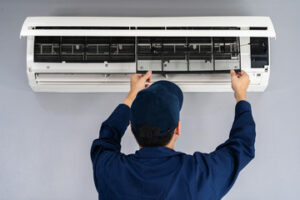Round Rock AC Repair involves restoring an air conditioner to working order. The process typically includes inspecting the system, servicing what needs service and performing repairs as needed.

Air conditioning maintenance tasks include cleaning or replacing air filters, lubricating fan motors and other moving parts, checking refrigerant levels (low levels indicate leaks), and tightening electrical connections. Regular upkeep improves indoor air quality, reduces energy bills and extends the unit’s lifespan.
Air filters are a critical part of an HVAC system. They clean the air inside your home and protect it from contaminating components like the blower, coils and ductwork. Air filters also help improve air quality by removing allergens, smoke, pollution, germs, mold and other harmful microorganisms. If you don’t maintain your filter, these contaminants can build up on the system and reduce its efficiency and performance, which will eventually cause problems that require heating and air service.
Keeping air filters free of obstructions and dirt saves energy and lowers utility bills. It also prevents the need for repairs and extends the lifespan of the system. A dirty filter, on the other hand, forces the system to work harder to compensate for restricted airflow. This extra strain can result in higher utility bills, shortened equipment lifespan and premature wear and tear.
There are many types of air filters, and the type you choose depends on the environment and health concerns of its occupants. For example, if you suffer from allergies, asthma or other respiratory conditions, you should consider purchasing filters with high MERV ratings. The MERV rating measures how effectively the filter traps and blocks different size particles. The higher the MERV rating, the better the filter will perform.
The actual and nominal filter sizes are also important factors to keep in mind. The actual size reflects the true measurements of the filter, while the nominal size is often rounded up to make the process of buying an air filter easier. You can avoid confusion by checking the filter’s label for its exact dimensions and selecting the right size.
When choosing an air filter, make sure to check the MERV rating to ensure it’s compatible with your HVAC system. A filter with a very high MERV rating can be too restrictive for your system, which will cause it to overheat and shorten its lifespan. You should also look for a filter that’s washable, as it’ll be easier to maintain and can save you money in the long run.
Evaporator Coil
The evaporator coil is an important part of your air conditioner. It holds the refrigerant that cools the air passing across it, and without it your AC would fail to function. Unfortunately, the copper pipes inside the evaporator coil can deteriorate, and the resulting leak will require immediate professional attention to avoid severe damage to your system and costly repair bills.
Like the condenser coil, the evaporator coil needs regular maintenance to perform at peak efficiency and maximize your equipment’s lifespan. This includes regularly changing the air filters and cleaning the evaporator coil with a soft brush, rinsing it with water and possibly using a UV light to prevent mold growth.
When the evaporator coil becomes dirty, it stops being able to absorb heat from the air flowing over it. This reduces your system’s cooling ability, and it can even cause the evaporator coil to freeze over. If this occurs, turn off your air conditioner and call a professional to inspect the problem.
The other common issue with the evaporator coil is simply that it’s old and worn out. While it might still be able to cool the air, the evaporator coil will have to work much harder than usual in order to do so. This will result in an increase in energy usage and a corresponding increase in your monthly utility bills.
There are several signs that indicate the evaporator coil is beginning to wear out, including diminished cooling and humidity removal performance. You might also notice an increase in your energy bills, or your home may begin to feel warmer despite setting your thermostat lower than normal.
While the evaporator coil is critical to your air conditioning’s functionality, it is not the most expensive component in the entire unit. The compressor, which is responsible for circulating the refrigerant throughout your air conditioning system, is considerably more expensive to replace than the evaporator coil. This is because the compressor is more fragile and requires a greater degree of care and maintenance to keep it running properly. The simplest way to ensure the longevity of your compressor is to get a routine checkup every year from a qualified HVAC technician.
Refrigerant
Refrigerant is an essential part of any AC system. This liquid works with the evaporator coils to absorb and transfer heat into warm air. It also regulates the pressure of the evaporator coils to ensure that they are cool and don’t overheat or damage the system.
When refrigerant levels are low, the evaporator coils and refrigerant lines freeze. This causes the AC to work harder to get the job done, which leads to high energy bills and system failure over time.
Low refrigerant levels often occur due to a leak in the system. Leaks can be caused by many factors, including improper service, faulty seals, worn components, and aging systems. Keeping an eye out for signs of refrigerant loss and scheduling routine maintenance with a qualified professional prevents problems like this from happening in the first place.
The most common sign of refrigerant leaks is warm air coming out of the vents. Other common symptoms include hissing noises, higher energy bills, and insufficient cooling. Refrigerant leaks can be dangerous because they allow corrosive refrigerant gas to escape into the indoor air, which can burn skin and cause respiratory issues in some people. Leaks should be repaired promptly, which helps your home stay comfortable while protecting the health of everyone in it.
Leaking refrigerant can be prevented by ensuring that all lines are properly insulated and tucked away from areas where they might be nudged or damaged by equipment, lawn supplies, or critters. It’s also important to regularly inspect the copper lines for dents, corrosion, and other structural damages. Repairing these issues as soon as possible protects the integrity of the copper and prevents refrigerant leaks.
Another way to avoid refrigerant leaks is to schedule routine maintenance with an experienced AC technician. During these inspections, the technician can check for problems that might lead to leaks and make sure that any refrigerant is topped up to the correct amount. This prevents overcharging the system, which is as damaging as being undercharged.
Refrigerants are an amazing compound that provides cool comfort while helping to preserve the environment. However, if they leak into the atmosphere, they can contribute to global warming and damage the ozone layer. Detecting and repairing leaks quickly protects your air conditioning system, supports EPA regulations, and reduces the impact of harmful gases on the environment.
Electrical Connections
If your AC is displaying electrical problems like short cycling, the problem could be caused by faulty wiring. This is often a result of poor installation or improper maintenance. Electrical wiring issues should be repaired by a professional to ensure your safety and avoid further damage to the system.
If you suspect your electrical wiring is faulty, contact a certified electrician for help. If you attempt to do the work yourself, you risk getting electric shock and causing further damage to the system.
A qualified technician will inspect the disconnect box and wiring to make sure they are in good condition before working on them. They will also check the line voltage to make sure your air conditioner is receiving enough power.
You can also tell if your AC wiring is faulty by noticing an increase in your energy bill. Incorrectly wired systems consume more electricity than they should, which can cause your bills to go up significantly.
The wiring in your home’s air conditioning is primarily composed of Romex wire. This type of wire has an insulated casing that helps protect it from issues like fraying, corrosion, and separation. If you notice the wires in your HVAC system have cracks or breaks, you should consider replacing them with new ones.
Fuses are used to control the current that runs through your system. They are sized to match the expected load and cable thickness to ensure your AC isn’t overworked. When fuses melt it means that the circuit is overloaded and needs to be fixed.
You might need a fuse replacement if your air conditioner is having frequent problems with short cycling. This is a sign that your system is having to restart frequently, which causes unnecessary wear and tear. You can test fuses using a multimeter, but it’s best to leave this job to an experienced technician.
The sequence of operations that your air conditioner follows is dictated by the control board. Sometimes the control board will need to be replaced if it is damaged or has failed. A trained technician will be able to replace the control board quickly and efficiently.



